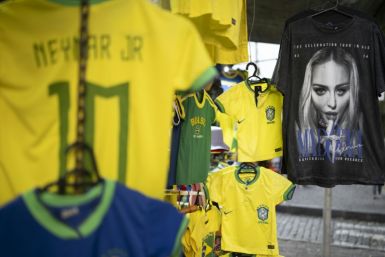Eighty-year old German Recluse Cornelius Gurlitt Doesn't Want to Part with Nazi Art Collection [PHOTOS] [VIDEO]
Cornelius Gurlitt, the eighty-year old German recluse who hoarded 1,400 art works for several years including the infamous Nazi Art collection, reportedly doesn't want to part with the said treasure (worth billions of dollars) that was recently taken by the authorities from him.
According to an interview with Õzlem Gezer of SPIEGEL, which was translated from the German language by Christopher Sultan and Paul Cohen, Gurlitt is appealing to the Augsburg public prosecutor's office and its customs investigators and officials (whom he refers to as "strangers") who seized his art hoard. He is said to be asking for the pictures to be returned to him.
"Saying goodbye to my pictures was the most painful of all," Gurlitt said in the SPIEGEL interview.
"I hope everything will be cleared up quickly, so I can finally have my pictures back," he added.
CREDIT: YouTube/ReutersVideo
Gurlitt also clarified that his father, Hildebrand Gurlitt, who worked as a museum director, an art critic and an art dealer for Adolf Hitler in Nazi Germany, did not extort any art from Jewish art collectors. Hildebrand helped establish modern art in Germany. After the year 1933, he did some business with the Nazis. He died in 1956.
According to Gurlitt, approximately 30 Augsburg customs investigators and officials unceremoniously marched into his apartment on Feb. 2012 to gather about 1,400 art works from his collection, including a painting by Marc Chagall, "Two Riders on the Beach" painting by Max Liebermann, "Village Girl with Goat" painting by Gustave Courbet, a self-portrait of the German expressionist and realist artist Otto Dix and an untitled Henri Matisse painting of a woman who is sitting, all of which he kept for decades. They even took a suitcase filled with his favorite pictures.
After Gurlitt's traumatic ordeal, he said that a woman was sent to counsel him but the visit was "horrible" and "gruesome" for him.
Now, his apartment is still pretty much empty. And, he is still being hounded by people about the Nazi art work collection.
The other works in the Gurlitt's seized Nazi art collection include works by Pablo Picasso, Franz Marc and Max Beckmann. Some of these works rightfully belong to him because he inherited it from his father, but neither he nor do the authorities and art experts know which one and how many among the collection.
"What do these people want from me? I'm just a very quiet person. All I wanted to do was live with my pictures. Why are they photographing me for these newspapers, which normally only feature photos of shady characters?" Gurlitt asked in the SPIEGEL report.
"At least they could have waited until I was dead to take away the pictures," he added.
Gurlitt wonders why there is still interest in the case even when it happened a long time ago. Throughout the interview he reminisced about the good old days when he still had the pictures that made him happy and his childhood days growing up in Hamburg.
Gurlitt has always been interested in art. He even studied art history at the University of Cologne after graduating from high school.
Cornelius insists that the pictures in the art collection came from art dealers or German museums and not from private individuals. He claimed that his father, Hildebrand, only cooperated with the Nazis to prevent the paintings from being burned.
"I've never committed a crime, and even if I had, it would fall under the statute of limitations. If I were guilty, they would put me in prison," said Cornelius in the SPIEGEL interview.
"I never had anything to do with acquiring the pictures, only with saving them," he added.
Gurlitt confirmed in his interview with SPIEGEL that he has received a letter informing him that a some of the confiscated art work are going to be returned to him, but he's not sure which ones will ultimately get back to him.
He talked about how he sold the painting "Lion Tamer" by expressionist Max Beckmann to the Lempertz auction house in Cologne, Germany for €725,000 ($978,000). He pocketed nearly €400,000 which he used for medical expenses. The rest of the money went to the heirs.
Gurlitt saw his seized paintings displayed in the newspapers. Again, he is reminded of his loss as tears well up in his eyes while wondering aloud about why his private property was put on display. He says that the paintings have to come back to him. He also plans to sell the Liebermann art work if ever it is returned to him, to pay for his hospital bills. But, he plans to return the others in his apartment to be hung on his bare walls.
"When I'm dead, they can do with them what they want," Gurlitt finally said towards the end of the SPIEGEL interview.
The eighty-year old German recluse Cornelius Gurlitt obviously doesn't want to part with his Nazi art collection. It's like he's married to his paintings, and vowed "Till death do us part," to each of these rare art works. Unfortunately, the marriage didn't last until the end of his days. But, he's still hoping some sort of "reconciliation" will take place in the near future.
The German magazine Focus first reported about the recovery of Gurlitt's paintings. Click HERE to see the article.
Click HERE to see some pictures of Cornelius Gurlitt's art collection.
READ MORE:
£1bn Treasure Trove Stolen by Nazis Found Amid Rotting Food in Munich Apartment [READ]
US Lawyers for Jewish Families Slam €1bn Nazi Art Seizure Process [READ]
Nazi-Looted Art Update: First Photos Of Cornelius Gurlitt's Collection, Authorities Want List Of Art Revealed [READ]






